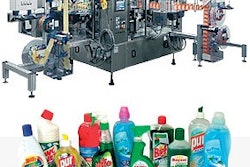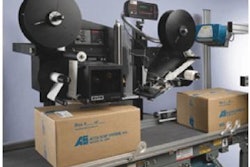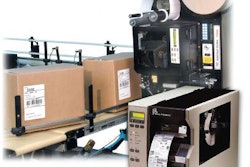IFCO Systems North America, Tampa, FL, is one of the first users in North America for ImageID’s Visidot™ technology for asset tracking. Visidot is claimed as a more robust application than bar codes and is said to be a lower-cost, more reliable alternative to radio-frequency identification (RFID) for track-and-trace purposes. It also permits simultaneous capture of data for multiple items; for example, an entire pallet load of Visidot-labeled assets can be read at once.
“It’s designed to track our assets–reusable plastic containers,” says Fred Heptinstall, senior vice president and general manager. “It’s a pretty slick system.” The IFCO-owned RPCs are leased to the company’s customers, which are grower and produce marketers.
IFCO’s system uses two parallel identifiers on separate 1¼2”x2” pressure-sensitive labels. There’s a one-dimensional European article number (EAN) 128 bar code on one, and on the other is Visidot’s ColorCode™, a series of four “color wheels” that is unique for each RPC. Each color represents a number, and so the combination of the numbers on the four color wheels is, in effect, a serialized, individualized number (see sidebar p. 44).
The ColorCode, which is digitally scanned by a Visidot reader, can be read at a more extreme angle than a bar code. Every RPC on an entire pallet load can be identified at once using the ColorCode technology. Visidot claims a proven read rate of 99.7% accuracy for millions of RPCs.
“The idea is that the ColorCode can be read using fixed digital cameras, and the bar codes can be read using conventional bar-code readers,” Heptinstall explains.
Although the ColorCode is the key identifier, the bar code provides RPC identification for portions of IFCO’s supply chain where the Visidot reader is not used.
IFCO Systems North America began rolling it out onto its RPCs starting in October 2004. “We are using Visidot on all our new containers,” Heptinstall says, adding that the company will probably be proficient with it in a few months when most of their containers will be Visidot track-and-trace enabled.
In Spring 2005, Heptinstall estimated that the Visidot labels appear on millions of IFCO’s “new generation” RPCs, which measure 60”x40” in various sidewall heights from 41¼3’’ to 11”. The hinged RPCs are injection-molded of black polypropylene copolymer, replacing the previous green ones.
Multiple-asset imaging
IFCO uses fixed-mount cameras that work in conjunction with Visidot’s proprietary software.
The Visidot imaging works very efficiently for a pallet, Heptinstall says. “You don’t need a bar-code scan of every RPC, you just have a digital picture taken of the entire load and you’ve captured all the RPCs.” Alternately, IFCO can associate the bar code or ColorCode of one RPC on a pallet for the entire unit load.
Visidot solves inventory control for them, Heptinstall says, adding, “it’s highly useful to know cycle time—when an RPC goes out to a specific grower or packer and when it is returned. That opens up more possibilities.”
The p-s Visidot labels are supplied preprinted in roll form and applied using online applicators at IFCO’s main facility in Baldwin Park, CA. The labels are affixed to the short ends of every RPC using a particularly aggressive adhesive to keep them on, according to Heptinstall. The bar-code label is applied to the right corner, and a Visidot ColorCode p-s label is applied to the left corner.
“The labels are extremely durable,” Heptinstall points out. But if any Visidot ColorCode label becomes damaged or missing, IFCO has installed supplemental applicators at the company’s regional warehouse locations.
Closed loop for now
The system is used by IFCO internally as a closed-loop system, but already some of its customers are assessing it for future track-and-trace applications, says Heptinstall: “If they do, it’s a very low-cost, more proficient way to do track-and-trace than any other system available.” There are also possibilities to track the RPCs all the way into a retail setting with a hand held scanner such as for a product recall, he notes: “You’d know which product RPCs needed recalling and which ones didn’t.”
There’s also an RFID angle: Heptinstall says that the software architecture used for Visidot will work with RFID. “When RFID technology works for produce at a reasonable cost, then we’ll be ready for it,” says Heptinstall.
Before, IFCO had tracked its assets manually. “Once we are fully transitioned over to Visidot, our asset-tracking system will be fully automatic,” he says.
Although Heptinstall declines to quantify IFCO’s cost savings, he acknowledges that it’s “significant. We’ve seen tremendous benefits in Europe, and we expect similar here.”
See sidebar to this article: The color wheel decoded



























